Please Take Note: This is a review of the final game, but it might change slightly based on the success of the Kickstarter campaign. The game is being reviewed on the components and the rules provided with the understanding that “what you see is not what you might get” when the game is published. If you like what you read and want to learn more, we encourage you to visit the Kickstarter campaign. Now that we have all that disclaimer junk out of the way, on with the review.

The Basics:
- For ages 8 and up (publisher suggests 10+)
- For 4 to 7 players
- Approximately 15 minutes to complete
Geek Skills:
- Active Listening & Communication
- Logical & Critical Decision Making
- Emotional Coping Skills
- Memorization
- Strategy & Tactics
- Cooperative & Team Play
- Self-confidence
- Bluffing and Misdirection
Learning Curve:
- Child – Easy
- Adult – Easy
Theme & Narrative:
- Stay alive and trust no one
Endorsements:
- Gamer Geek approved!
- Parent Geek approved!
- Child Geek approved!
Overview
The woods surrounding the village are dark, deep, and old. Children are taught not to go near it and only the bravest (or the most foolish) adults venture into its depths. The wood hides something that stays in the shadows, but not any longer. There have been animal attacks in the village and rumors are starting to be whispered from ear to ear that a werewolf is responsible. Villagers no longer trust one another and everyone is a possible enemy.
GROWL, designed and self-published by by Joey Vigour, will reportedly be comprised of 54 cards, 7 Objective tiles, and 20 tokens. As this is a review of a prepublished game, I cannot comment on the game component quality. Lead artist Angelina Chernyak has made each card colorful and dripping with thematic elements (dark night, full moon, etc.), further enhancing the game’s narrative.
A Village With a Dark Secret
To set up the game, first give each player an Objective tile. These tiles detail the goal of a player depending on if they are a Werewolf or a Human. These tiles are always visible in the game and should be placed directly in front of the player. This creates the player’s “Home Area” where cards will be placed during the game. Make sure the “I Died” side of the tile is face-down. Place any remaining Objective tiles not used back in the game box.
Second, find and set aside the Night and Final Night cards.
Third, take the remaining cards and set aside a mix of Gold cards and one to two Bite cards (depending on the number of players). This is the Setup Deck. Shuffle this deck and deal one card to each player, face-down. Players should look at this card but keep it hidden from their opponents. Depending on the card they were given they will either be a Human (Gold card) or a Werewolf (Bite card). Any player who receives the Bite card at this time is considered “Werewolf Zero” and is always a Werewolf regardless of the cards in their hand.
Fourth, remove a set number of Wound and Bite cards from the game per the number of players and shuffle the remaining cards. This is the Main deck. From the Main deck, deal three cards to each player, face-down. These cards should be looked at by the player but kept hidden from their opponents. This is the player’s starting hand. If any player has three Wounds, they reveal them now, the three Wound cards are placed back in the Main deck (which is reshuffled), and then dealt an additional three cards. Place the Main deck face-down in the middle of the game playing area. Yes, it’s possible for a player to become a Werewolf at this time, however they are not considered to be Werewolf Zero.
Fifth, take the previously set aside Night and Final Night cards. Randomly select one Final Night card and place it on top of the Main deck, face-down. Randomly select one Night card and place it roughly one-third of the way through the Main deck. Randomly select another Night card and place it roughly two-thirds of the way through the Main deck. Place any remaining Night and Final Night cards back in the game box without looking at them. Now take the Main deck and flip it over, so the bottom card is now on top and face-up. The Final Night card that was on top of the deck is now at the bottom.
That’s it for game set up. Determine who will go first and begin.
In the Company of Werewolves
GROWL is played in rounds, phases, and turns. A typical round is summarized here.
Day Phase
If it’s the player’s turn (referred to here as the active player), they take a look at the top card on the Main deck and read it out loud. Cards will either be Gold, Wound, Hex, Salve, Charm, or Bite. All the players now openly debate and make their case regarding who should receive the card. This is done out in the open and can take as long as the players feel is necessary.
The active player cannot keep the card and must give it to another player. Once the active player has heard all they want to in regards to the pros and cons of giving the card to specific players, they take the top card and give it to the player of their choice. This given card goes into the player’s hand. The next player in turn order sequence now goes, announcing the new revealed card and the debate begins again.
Cards negate each other in real-time. A card is considered “active” that has not been negated by any other card automatically in real-time. This means if a player receives a Wound and a Salve at the same time, the cards are negated and the player does not take them into account. The same goes for Bites and Charms. A Bite card received during the last debate, for example, is not negated by a Charm card earned during the next debate or later passed to the player in the game.
Bite cards indicate that the player has been attacked by a Werewolf. If a player ever has three or more active Bite cards in their hand, they are now a Werewolf for the duration of the game. Their objective changes, as well. When a player becomes a Werewolf, they do NOT announce it to their opponents. Instead, they keep it a secret.
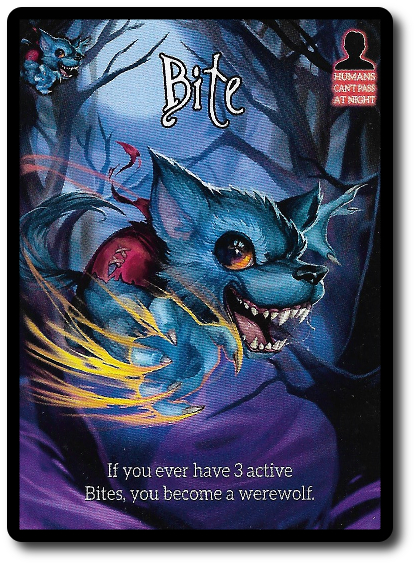 Charm cards negate Bite cards. For every Charm card in the player’s hand, one Bite card is now considered “cancelled”. Unless the player is already a Werewolf (having received three or more Bite cards without Charms to protect them or they are Werewolf Zero).
Charm cards negate Bite cards. For every Charm card in the player’s hand, one Bite card is now considered “cancelled”. Unless the player is already a Werewolf (having received three or more Bite cards without Charms to protect them or they are Werewolf Zero).
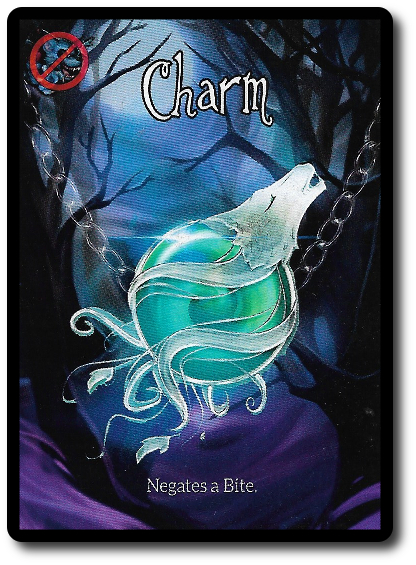
Hex cards are the suck. If a player has any in their hand, all Charm cards also in their hand are negated. POOF! No more magical protection for you!
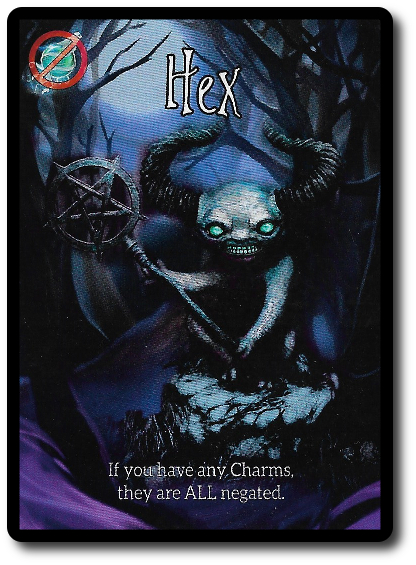
Wound cards are bad news for both Humans and Werewolves. Wound cards represent damage inflicted on the player. If a player ever has three or more Wound cards in their hand, they are considered “dead”. The player places their hand of cards face-down in front of them (not revealing any) and flips their Objective card over to the “I Died” side. They no longer participate in the game, but are still able to win or lose. They should remain nearby and quietly observe.

Salve cards negate Wound cards. For every Salve card in the player’s hand, one Wound card is now considered “cancelled” (or healed, I suppose).
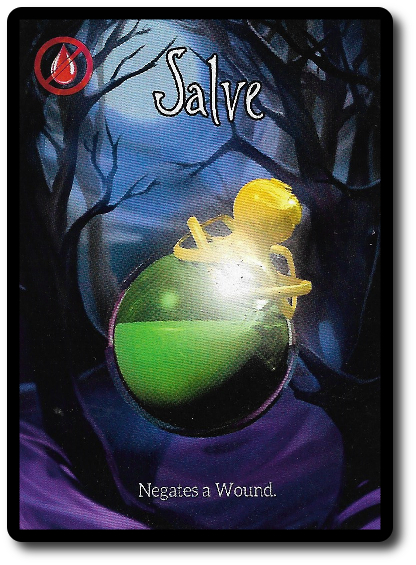
Gold cards count as points. If only playing a single game of GROWL, they do nothing in the game other than being a safe card to collect and pass, but have no other value. If playing multiple games of GROWL in a row, Gold cards will be counted at the end of each game to award the player points.

The players continue to debate who gets what card in turn order sequence until a Night card is revealed. When it is, the next phase of the round is triggered.
Night Phase
The Night phase of the game is triggered three times during the game (two from a Night card randomly placed in the deck and the last card which is the Final Night card at the bottom of the deck). The active player now reads the Night (or Final Night) card’s instructions out loud and follows them, resolving the Night card as required. Several actions can take place depending on the Night card revealed. A few Night card actions are summarized here.
- Place any one card from your hand on an opponent’s Home Area or instruct an opponent to give you a card
- Select one player to not shuffle any cards placed in their Home Area (allowing this player to know who passed what cards during this phase of the game)
- Temporarily remove one player from the Night phase (they do not participate in the current Night phase, but are not out of the game)
- Look at any opponent’s hand of cards
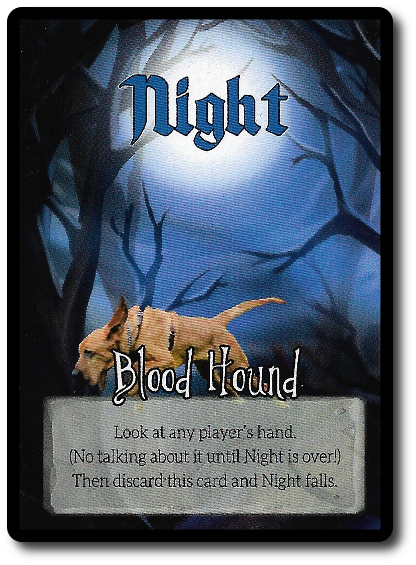
After the Night card is resolved, each player selects one card from their hand to pass to the opponent on their left and one card to pass to the opponent on their right. These cards are placed face-down and directly on top of the player’s Home Area. Only “alive” players participate at this time. If a player has died, the next alive opponent to their left and right are considered “adjacent” when it comes to passing cards.
The only restriction here is that players who are still Human cannot pass Bite cards. Werewolf players can (and should). This means that a player can become a Werewolf during the Day phase and infect Humans during the Night phase. Players need to keep track of their current state in their mind, as there is nothing in the game to help the player remember if they are a Werewolf or Human.
Players take the cards they are passed, shuffle, and then inspect them. Shuffling is important as it makes certain the player doesn’t know which card was given to them from which opponent. The only reason not to is if a Night card gave the player the ability to avoid the shuffle. These cards are then added to the player’s hand, making sure to note if they cancel each other out. The player should now look through their hand to determine if they have turned into a Werewolf or are dead.
The Night card is then discarded (unless it says otherwise), revealing the next card to be debated. This ends the Night phase and a new Day phase now begins with a new round.
The Final Night and Winning (or Losing) the Game
When the Final Night card is revealed it’s resolved and the GROWL is triggered. The player who is Werewolf Zero (assigned during game set up) growls out loud or announces they are the first Werewolf (whatever floats your boat). The other Werewolves (alive or dead) also identify themselves, but only after Werewolf Zero. Feel free to be as dramatic as you like here. When done, all the players will reveal their current allegiance.
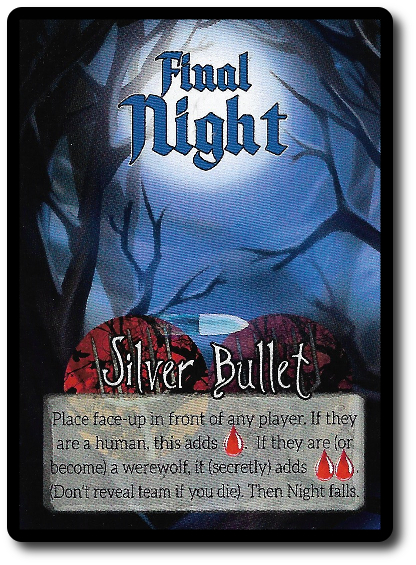
The Werewolf players (alive or dead) win the game if there are no more Human players left after the Final Night card is resolved.
The Human players (alive or dead) win the game if at least one Human player is still alive after the Final Night card is resolved.
Game Variant
If playing multiple rounds of GROWL, count the number of Gold cards each player has in their hand who are on the winning side (alive or dead). Keep track of these points using the tokens or some other method (pen and paper, pennies, etc.). Only those players who are on the winning side count their points and continue to do so at the end of each game. When the final game is played and completed, the player with the most points is crowned the Wolf King or Wolf Queen.
To learn more about GROWL, visit the game’s Kickstarter campaign.
Final Word
 The Child Geeks, as predicted, loved the game. They are always up for a game of Are You a Werewolf? and GROWL was considered to be an easier game to play. Why you ask? According to one Child Geek, “I like how the game is all about managing your cards and infecting others by passing the cards – or better yet – not infecting others!” So very true! This is a game where the player can, to a certain degree, control their fate and the outcome of the game. As one Child Geek put it, “What I like most is infecting other players by biting them. Grrrr!” The only aspect of the game that our Child Geeks had trouble with was remembering if they were a Werewolf or not. Games are not very long, but they are rather intense. There were several games that ended with a small number of our players not remembering if they were a Werewolf or still a Human. Whoops! Didn’t matter, though, as all the Child Geeks voted to approve GROWL.
The Child Geeks, as predicted, loved the game. They are always up for a game of Are You a Werewolf? and GROWL was considered to be an easier game to play. Why you ask? According to one Child Geek, “I like how the game is all about managing your cards and infecting others by passing the cards – or better yet – not infecting others!” So very true! This is a game where the player can, to a certain degree, control their fate and the outcome of the game. As one Child Geek put it, “What I like most is infecting other players by biting them. Grrrr!” The only aspect of the game that our Child Geeks had trouble with was remembering if they were a Werewolf or not. Games are not very long, but they are rather intense. There were several games that ended with a small number of our players not remembering if they were a Werewolf or still a Human. Whoops! Didn’t matter, though, as all the Child Geeks voted to approve GROWL.
 The Parent Geeks also enjoyed the game, finding it to be one of the easiest to play (but not to win) versions of Werewolf they had the good fortune to experience. According to one Parent Geek, “What I don’t like about the other versions of the game is the need to have a large group and a lot of arguing. This game variant feels much more streamlined and more table-top friendly. I really enjoyed it.” Another Parent Geek said, “I have a love-hate relationship with hidden objective/role games. Not the case here. I really liked it. My only comment would be that there needs to be some way for a player to keep track of who they are. I suggest a Role card that can easily sit in the player’s hand and can be used to help keep track.” An excellent idea, but not altogether necessary. Games are not that long to warrant it, but it could be useful. When all the nights and days had passed, the Parent Geeks voted to approve GROWL.
The Parent Geeks also enjoyed the game, finding it to be one of the easiest to play (but not to win) versions of Werewolf they had the good fortune to experience. According to one Parent Geek, “What I don’t like about the other versions of the game is the need to have a large group and a lot of arguing. This game variant feels much more streamlined and more table-top friendly. I really enjoyed it.” Another Parent Geek said, “I have a love-hate relationship with hidden objective/role games. Not the case here. I really liked it. My only comment would be that there needs to be some way for a player to keep track of who they are. I suggest a Role card that can easily sit in the player’s hand and can be used to help keep track.” An excellent idea, but not altogether necessary. Games are not that long to warrant it, but it could be useful. When all the nights and days had passed, the Parent Geeks voted to approve GROWL.
 The Gamer Geeks very much enjoyed the game, finding it to capture the intensity of Are You a Werewolf? but without the need to have a lot of people on hand to play it. According to one Gamer Geek, “One aspect of the traditional game that I never liked is that inexperienced players could ruin the game. They could accidentally reveal they are a werewolf or not participate fully, making the game drag a bit. In this version, the debate is over cards and how hard you debate for or against a card is really interesting and revealing!” Another Gamer Geek said, “An excellent new variant to one of my favorite games to play at gaming conventions and family gatherings. I might just make this my new favorite!” When all the votes were in, the Gamer Geeks agreed that GROWL was a game they all enjoyed and would play again.
The Gamer Geeks very much enjoyed the game, finding it to capture the intensity of Are You a Werewolf? but without the need to have a lot of people on hand to play it. According to one Gamer Geek, “One aspect of the traditional game that I never liked is that inexperienced players could ruin the game. They could accidentally reveal they are a werewolf or not participate fully, making the game drag a bit. In this version, the debate is over cards and how hard you debate for or against a card is really interesting and revealing!” Another Gamer Geek said, “An excellent new variant to one of my favorite games to play at gaming conventions and family gatherings. I might just make this my new favorite!” When all the votes were in, the Gamer Geeks agreed that GROWL was a game they all enjoyed and would play again.
 I love Are You a Werewolf? Love it to a point where I actively seek out the game during game conventions and always find a way to play it with larger groups whenever possible. The problem is, you need to be a gamer to really enjoy it. There is a lot going on under the covers (so to speak) that an inexperienced or new player misses. This is most commonly referred to as the “meta game” (the game in the game) and it is, by far, the most important aspect of the game play. It’s also the most invisible. Not the case with GROWL. The objective is the same, but how one goes about playing the meta game is much more visible. As a result, players are able to actively participate at a deeper level right from the start, regardless of their previous experience with games.
I love Are You a Werewolf? Love it to a point where I actively seek out the game during game conventions and always find a way to play it with larger groups whenever possible. The problem is, you need to be a gamer to really enjoy it. There is a lot going on under the covers (so to speak) that an inexperienced or new player misses. This is most commonly referred to as the “meta game” (the game in the game) and it is, by far, the most important aspect of the game play. It’s also the most invisible. Not the case with GROWL. The objective is the same, but how one goes about playing the meta game is much more visible. As a result, players are able to actively participate at a deeper level right from the start, regardless of their previous experience with games.
The Parent Geek who suggested the a card be added to the game that helps keep track of a player’s current state (Werewolf or Human) is a good idea and easily created if needed. We used small index cards with “HUMAN” written on one end and “WEREWOLF” written on the other. Depending on the player’s current state, they kept the right word at the top, easily allowing the player to know who they were. The only problem here is that when a player rotates their card, they are telling any player who is watching them that they have turned. This leads me to believe that while the idea is a good one, it’s not appropriate for the game. Players will need to keep track in their head, but this is not that difficult.
What can be done is adding a card to the player’s hand that is blank. Anything to left of the blank card is negated (not taken into account). Anything to the right is active. This makes it easier for the player to keep track of what cards cancel each other out, but does not help with keeping track if they are a Werewolf or not. We tried it and it worked.
Another aspect of the game I liked was that you really don’t know who is who for certain unless you go out of your way to communicate it. This made it tricky to determine what side an opponent was on and challenged each player to be as creative (and careful) as possible to learn if an opponent was a friend or foe. The debates during the Day phase do a lot here, but are not overly telling. They add insight, for certain, but nothing concrete. Nor does the passing of cards. It’s when you combine the two that you start to get a better picture. Nothing absolute, but clear enough to feel comfortable with your choices. Unless of course you guessed wrong…
I have always had a warm spot in my heart for deduction and hidden role games. It all started with Clue and continues to this day. GROWL is certainly going to be one of my new favorites. It hits all the right spots, scratches all the right itches, has just the right amount of intensity, and player interaction, keeping me guessing and debating from start to finish. Excellent stuff. Do try GROWL when time permits. It’s a howling good time!
Wow, horrible pun…very sorry.
This is a paid for review of the game’s final prototype. Although our time and focus was financially compensated, our words are our own. We’d need at least 10 million dollars before we started saying what other people wanted. Such is the statuesque and legendary integrity of Father Geek which cannot be bought except by those who own their own private islands and small countries.



